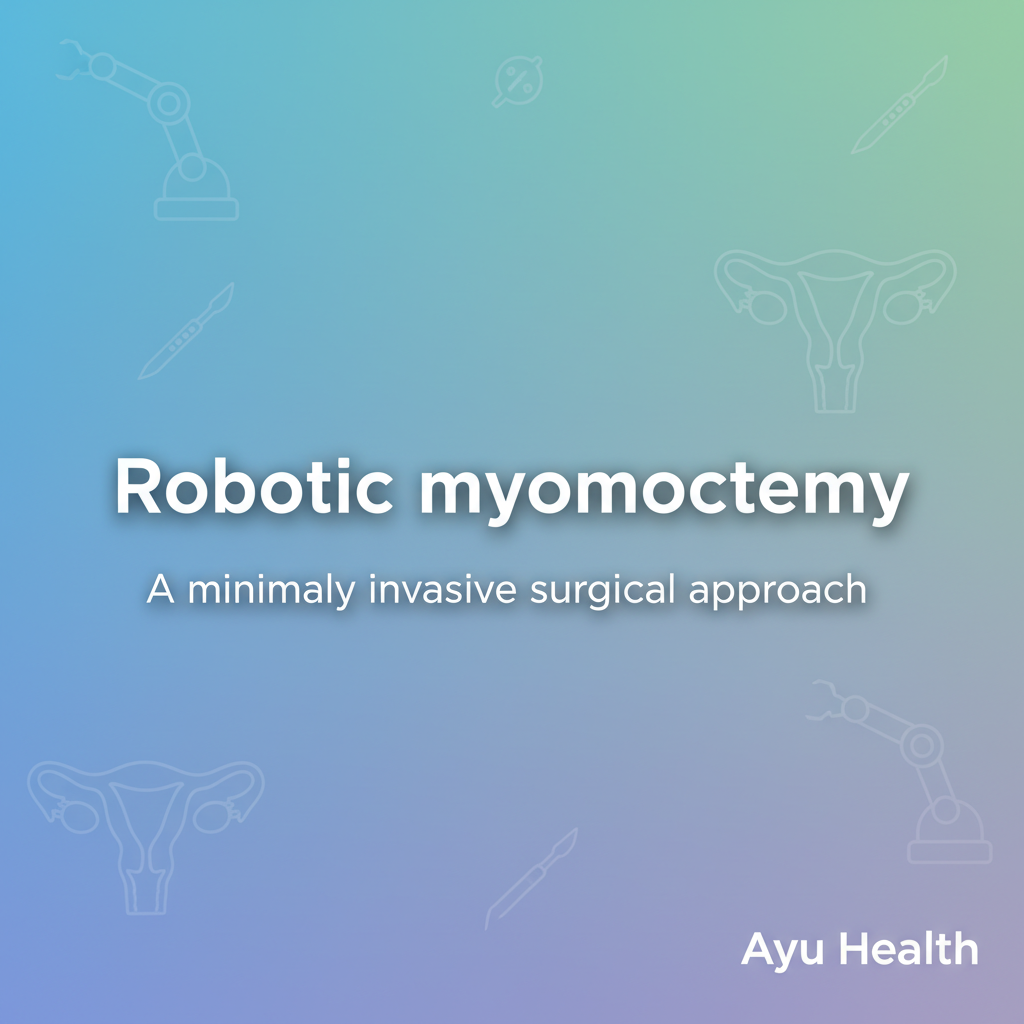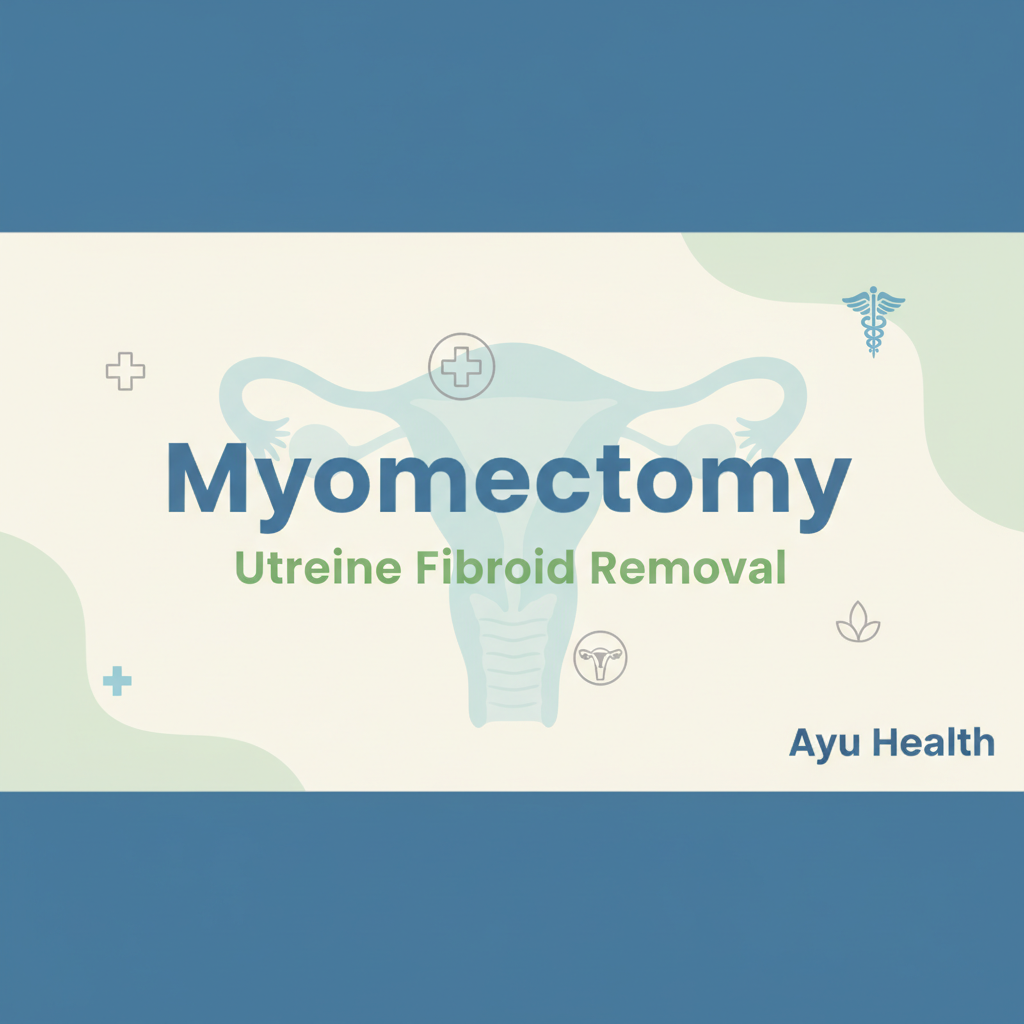Robotic Myomectomy: A Precise Path to Freedom from Fibroids for Indian Women
Uterine fibroids, non-cancerous growths that develop in the uterus, affect a significant number of women in India, often impacting their quality of life, fertility, and overall well-being. From heavy, painful periods to pelvic discomfort and even challenges in conceiving, the symptoms can be debilitating. For many Indian women, preserving the uterus is paramount, especially when planning a family or due to cultural considerations.
In this landscape, advanced medical technologies offer promising solutions. Among them, Robotic Myomectomy stands out as a revolutionary, minimally invasive surgical procedure specifically designed to remove uterine fibroids while safeguarding the uterus. This sophisticated approach leverages robotic precision to offer Indian patients a pathway to relief with enhanced recovery and improved outcomes.
This comprehensive guide, brought to you by Ayu, delves into the intricacies of robotic myomectomy, exploring its purpose, procedure, remarkable benefits, potential risks, and the cost considerations specific to India.
Why is Robotic Myomectomy Performed?
The primary purpose of robotic myomectomy is to alleviate the often-distressing symptoms caused by uterine fibroids and to restore uterine health, particularly for women who wish to preserve their fertility or avoid a hysterectomy.
Uterine fibroids can manifest a wide range of symptoms, profoundly impacting a woman's daily life. These symptoms often include:
- Heavy Menstrual Bleeding (Menorrhagia): This is one of the most common and debilitating symptoms, leading to anemia, fatigue, and disruption of daily activities. For many Indian women, heavy bleeding can also interfere with religious practices and social engagements.
- Prolonged Menstrual Periods: Bleeding that lasts longer than seven days can be exhausting and significantly reduce a woman's quality of life.
- Severe Pelvic Pain or Pressure: Fibroids can press on surrounding organs, causing chronic pelvic pain, a feeling of fullness, or pressure in the lower abdomen.
- Frequent Urination or Difficulty Emptying the Bladder: Large fibroids can press on the bladder, leading to increased urinary frequency or a sensation of incomplete bladder emptying.
- Constipation: If fibroids press on the rectum, they can cause constipation.
- Backache or Leg Pain: Fibroids can sometimes press on spinal nerves, leading to pain in the back or legs.
- Infertility or Pregnancy Complications: Fibroids can interfere with conception by blocking fallopian tubes, distorting the uterine cavity, or impacting embryo implantation. For those who conceive, fibroids can increase the risk of miscarriage, preterm labor, or complications during delivery. Addressing fibroids is often a crucial step for Indian women struggling with infertility.
Robotic myomectomy is often recommended for women who:
- Desire Future Conception: It is a fertility-sparing procedure, making it an ideal choice for women in their reproductive years who wish to become pregnant.
- Want to Avoid a Hysterectomy: For many, the idea of removing the uterus (hysterectomy) is emotionally and physically challenging. Robotic myomectomy offers an alternative that preserves the uterus.
- Have Large or Multiple Fibroids: The enhanced precision and 3D visualization of the robotic system make it particularly effective for removing large fibroids (often greater than 8 cm) or numerous fibroids (sometimes 5 or more), which can be challenging with conventional laparoscopic techniques.
- Have Fibroids in Challenging Locations: Fibroids located deep within the uterine wall (intramural), protruding into the uterine cavity (submucosal), or growing on the outer surface (subserosal) can all be effectively targeted using robotic assistance, especially those in difficult anatomical positions.
- Have Failed Other Treatments: When medication or less invasive procedures have not provided adequate relief, myomectomy becomes a viable surgical option.
By addressing the root cause of these symptoms – the fibroids themselves – robotic myomectomy aims to restore comfort, improve fertility potential, and enhance the overall health and well-being of the patient, all while upholding the sanctity of the uterus.
The Robotic Myomectomy Procedure
Robotic myomectomy is a highly precise and technically advanced surgical procedure. Performed under general anesthesia, it typically follows a structured sequence of steps, each designed to ensure the safe and effective removal of fibroids while preserving uterine integrity.
1. Anesthesia and Patient Positioning:
- General Anesthesia: You will receive general anesthesia, rendering you completely unconscious and pain-free throughout the procedure. An anesthesiologist continuously monitors your vital signs.
- Positioning: You will be positioned on the operating table, often in a lithotomy position (legs in stirrups), to provide the surgeon with optimal access to the pelvic area.
2. Incisions and Abdominal Insufflation:
- Small Incisions: The surgeon makes several small incisions, typically 4 to 5, each about 0.5 to 1 cm in length, in the abdominal area. These are strategically placed, often around the navel and in the lower abdomen, to allow insertion of the robotic instruments and camera.
- Carbon Dioxide Insufflation: A small needle is inserted into the abdomen to inflate the abdominal cavity with carbon dioxide gas. This creates a space between the abdominal wall and the internal organs, providing the surgeon with a clearer, unobstructed view and more room to maneuver the instruments without damaging surrounding tissues. This process is called pneumoperitoneum.
3. Robotic System Docking and Instrument Insertion:
- High-Definition 3D Endoscope: A slender instrument with a high-definition, three-dimensional camera (endoscope) is inserted through one of the incisions. This camera transmits a magnified, crystal-clear image of the surgical field to a monitor at the surgeon's console.
- Robotic Instruments: Specialized robotic instruments, which mimic the human wrist with seven degrees of freedom, are then inserted through the other small incisions. These instruments are designed for precise cutting, grasping, suturing, and cauterization.
- Docking the Robot: The robotic surgical system (e.g., Da Vinci Surgical System) is positioned over the patient, and its robotic arms are "docked" or connected to the inserted instruments.
4. Surgeon's Control Console:
- Remote Manipulation: The surgeon moves to a control console, situated a few feet away from the operating table. From this console, the surgeon views the 3D, magnified images on a screen and manipulates the robotic arms using hand and foot controls.
- Enhanced Precision and Dexterity: The robotic system translates the surgeon's hand movements into smaller, more precise movements of the instruments inside the patient's body. The system also filters out any natural tremor, enhancing surgical stability and precision far beyond what is possible with human hands or conventional laparoscopy.
5. Fibroid Excision and Uterine Repair:
- Meticulous Dissection: Under the enhanced visualization and control, the surgeon carefully identifies each fibroid. Using the robotic instruments, the fibroids are meticulously dissected and enucleated (shelled out) from the uterine wall. The precision of the robotic arms allows for minimal damage to the healthy surrounding uterine muscle tissue.
- Uterine Wall Reconstruction: After the fibroids are removed, the incisions made in the uterine wall are carefully and meticulously stitched back together in multiple layers. This multi-layered suturing is a critical step, especially for women desiring future pregnancies, as it helps to restore the structural integrity and strength of the uterus, significantly reducing the risk of uterine rupture in subsequent pregnancies. The robotic system's ability to perform complex suturing with high precision is a major advantage.
6. Fibroid Removal from the Body:
- Morcellation: Once the fibroids are excised and the uterus repaired, the removed fibroids need to be extracted from the abdominal cavity. For larger fibroids, this often involves a technique called morcellation. The fibroids are placed into a protective bag (contained morcellation) within the abdomen and then broken down into smaller pieces using a specialized mechanical device (morcellator) inside the bag. This allows the pieces to be removed through one of the small incisions without spreading tissue fragments within the abdominal cavity.
- Direct Removal: Smaller fibroids may be removed directly through one of the incisions, sometimes with slight enlargement of the incision.
7. Final Steps:
- Inspection and Irrigation: The surgical area is thoroughly inspected for any bleeding, and the abdominal cavity is irrigated with saline solution to cleanse it.
- Instrument Removal: The robotic instruments and endoscope are carefully removed.
- Gas Release: The carbon dioxide gas is released from the abdomen.
- Incision Closure: The small abdominal incisions are closed with sutures or surgical tape.
The entire procedure typically takes between 2 to 4 hours, depending on the number, size, and location of the fibroids. Following the surgery, you will be moved to a recovery room for close monitoring as you emerge from anesthesia.
Costs in India
The cost of robotic myomectomy in India can vary significantly, reflecting the advanced nature of the technology, the expertise involved, and regional economic differences. It's important to understand the factors that influence the overall expenditure.
General Cost Range:
- Based on various sources, the cost of robotic myomectomy in India typically ranges from approximately ₹2,00,000 to ₹4,00,000 (roughly $2,400 to $4,800 USD). Some estimates for complex cases or premium hospitals in metropolitan cities might even go higher.
- It's important to note that while some older sources might indicate lower ranges for "laparoscopic/robotic myomectomy," robotic myomectomy is generally more expensive than conventional laparoscopic myomectomy due to the specialized equipment and technology involved.
Factors Influencing the Cost:
-
Hospital Type and Location:
- Tier-1 Cities vs. Tier-2/3 Cities: Hospitals in major metropolitan areas like Delhi, Mumbai, Bangalore, Chennai, Hyderabad, and Kolkata generally have higher costs due to higher operating expenses, infrastructure, and demand.
- Hospital Category: Private corporate hospitals and super-specialty hospitals, which invest in state-of-the-art robotic systems and offer premium services, will typically have higher charges than smaller private hospitals or government institutions.
-
Surgeon's Fees:
- The experience, reputation, and seniority of the operating surgeon significantly impact the overall cost. Highly experienced robotic surgeons with a proven track record will command higher fees.
-
Severity and Complexity of the Condition:
- Fibroid Characteristics: The size, number, and location of the fibroids directly affect the complexity and duration of the surgery. Removal of very large, multiple, or deeply embedded fibroids will likely incur higher costs.
- Associated Conditions: If there are other co-existing gynecological conditions that need to be addressed during the same surgery, the cost will increase.
-
Robotic System Usage and Consumables:
- Robotic surgery involves the use of specialized, single-use robotic instruments and drapes, which contribute a significant portion to the overall cost. The initial fixed cost of the robotic system itself is substantial, and this is factored into procedure costs.
-
Pre-operative Diagnostic Tests:
- Costs associated with necessary diagnostic tests like pelvic ultrasound, MRI, blood tests (CBC, coagulation profile, kidney/liver function), ECG, and chest X-ray are added to the total. A detailed MRI, for instance, can cost between ₹8,000 to ₹15,000 or more.
-
Anesthesia Fees:
- The anesthesiologist's fees, covering the administration of general anesthesia and continuous monitoring during the procedure, are a separate component of the total bill.
-
Hospital Stay Duration:
- While robotic myomectomy typically involves a shorter hospital stay (1-2 days), any extended stay due to complications or patient preference will increase room charges and nursing care costs.
-
Medications and Post-operative Care:
- Costs for pre-operative medications (e.g., antibiotics, iron supplements), intraoperative medications, and post-operative pain management, antibiotics, and follow-up consultations are also included.
Insurance Coverage in India:
- Insurance coverage for robotic-assisted surgery in India is expanding. Many health insurance providers now cover the procedure, understanding its benefits.
- However, the extent of coverage can vary significantly between policies and providers. Some plans may cover the entire cost, while others might have sub-limits for specific components (e.g., room rent, surgeon's fees) or might not cover the "additional cost" associated with robotic technology versus traditional surgery.
- It is crucial for patients to:
- Verify with their insurer: Contact their health insurance provider well in advance to understand the specifics of their policy regarding robotic surgery.
- Obtain pre-authorization: Ensure that the hospital and surgeon assist in obtaining pre-authorization from the insurance company to streamline the process.
Value vs. Cost:
While robotic myomectomy is generally more expensive than open or conventional laparoscopic myomectomy, the benefits often outweigh the higher upfront cost for many patients. The quicker recovery, shorter hospital stay, reduced pain, minimal scarring, and improved fertility outcomes can lead to fewer days off work, lower out-of-pocket expenses for extended recovery, and a significantly better overall patient experience. Efforts are continuously being made in India to reduce the cost of robotic surgery consumables and instruments to make this advanced technology more accessible to a wider population.
FAQ (Frequently Asked Questions)
1. What are uterine fibroids? Uterine fibroids are non-cancerous (benign) growths that develop in the muscular wall of the uterus. They vary in size, number, and location and can cause symptoms like heavy bleeding, pelvic pain, pressure, and fertility issues.
2. Who is an ideal candidate for robotic myomectomy? Ideal candidates are typically women suffering from symptomatic fibroids who wish to preserve their uterus, especially those desiring future pregnancies. It is particularly beneficial for women with large, multiple, or complex fibroids that might be challenging to remove with other minimally invasive techniques.
3. How long is the recovery period after robotic myomectomy? Patients typically have a significantly faster recovery compared to open surgery. Most are discharged from the hospital within 1-2 days and can return to light activities within 1-2 weeks. A full recovery, including strenuous exercise, usually takes 4-6 weeks.
4. Can fibroids grow back after robotic myomectomy? While robotic myomectomy effectively removes existing fibroids, it cannot prevent new fibroids from developing. There is a recurrence rate of approximately 25% over 5-10 years, depending on factors like age and the number of fibroids originally present. Regular follow-up is recommended.
5. Is robotic myomectomy covered by insurance in India? Yes, many health insurance policies in India now cover robotic-assisted surgery, including robotic myomectomy. However, coverage limits and specific terms can vary widely. It is crucial to check with your insurance provider and obtain pre-authorization before the procedure.
6. What are the alternatives to robotic myomectomy? Alternatives include:
- Watchful Waiting: For asymptomatic fibroids.
- Medications: To manage symptoms (e.g., hormonal therapy, GnRH agonists).
- Uterine Artery Embolization (UAE): A minimally invasive procedure to cut off blood supply to fibroids.
- Hysteroscopic Myomectomy: For fibroids protruding into the uterine cavity.
- Laparoscopic Myomectomy: Traditional minimally invasive surgery.
- Open Myomectomy: Traditional open abdominal surgery.
- Hysterectomy: Surgical removal of the uterus (a definitive solution, but not uterus-sparing).
7. How soon can I try to conceive after the surgery? Most surgeons recommend waiting at least 3 to 6 months after robotic myomectomy before attempting conception. This allows the uterine wall to heal completely and regain its strength, minimizing risks during pregnancy. Your surgeon will provide specific guidance based on the extent of your surgery.
8. Is robotic surgery safer than traditional open surgery? Robotic myomectomy is generally considered safer than traditional open surgery due to its minimally invasive nature. It leads to less blood loss, reduced pain, lower risk of infection, shorter hospital stays, and quicker recovery. While it carries its own set of risks, its precision and enhanced visualization often contribute to better outcomes in skilled hands.



